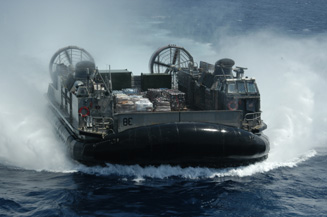The USS Kearsage, specialist in military humanitarian intervention

Two American ships - the amphibious assault ship, helicopter carrier USS Kearsarge (LHD-3) with 400 marines and the amphibious transport ship USS Ponce (LPD-15) - are about to enter the Suez Canal, US Defense Secretary Robert Gates said on Tuesday. Their entrance in Mediterranean is scheduled for Wednesday around 14 p.m. GMT, said a canal official quoted by Reuters (It takes 8 to 12 hours to cross the Suez Canal) (*). And the ships could be off eastern Libya and Benghazi within 24 hours (depending on route chosen, around 800 miles to go). The USS Kearsage deserves a little pause.
A ship for land expedition
The USS Kearsage is particularly well suited to a mixed mission: security and humanitarian; on the other hand, it has a low propensity for the establishment of a no-fly zone; its vocation being more the propulsion or the support of forces on land. Able to move at a speed of 24 knots, it has, in fact, a landing capacity, with its barges and aircrafts, but also its bridge and steerage which can accommodate around fifty aircraft: 42 Helicopters CH-46 Sea Knight used for troop transport or medical evacuations and 6 helicopters Sikorski H-60F/HH-60H multi-role (combat, Search and Rescue, medical evacuation...) as well as 5 vertical take-off aircraft AV-8B Harrier II.
It has a particularity: a hospital capacity that allows it to treat up to 600 patients, with 4 operating rooms and 2 emergency rooms. It can thus supplement the hospital ships USNS Comfort and Mercy.
Commitments in Kosovo, in Iraq but mainly "military-humanitarian", since
The USS Kearsage has been engaged on several occasions: in 1997 to help evacuate Americans from Sierra Leone; in 1999 in the Adriatic for operation Noble Anvil (Albania) then Guardian Force (Macedonia, Kosovo - where its marines were the first soldiers, US, to enter after the British and the French); in 2003, in support of Operation Enduring Freedom (Iraq). He was the target in 2005 in the port of Aqaba (Jordan) of a terrorist rocket attack which failed. Since then, he has specialized in military-humanitarian operations: in 2007, for Operation Sea Angel II to rescue the victims of Cyclone Marian (Bangladesh); in 2008 after the passage of several cyclones in the Caribbean (Haiti); in 2010 after the floods (Pakistan).
(*) Updated with the latest information (Tuesday 13 p.m.).

